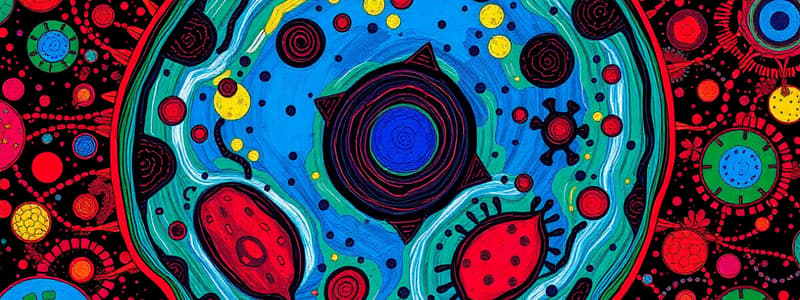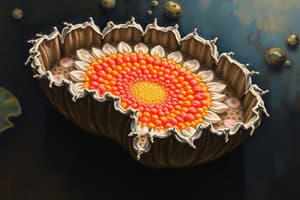Podcast
Questions and Answers
Match the following cell structures with their functions:
Match the following cell structures with their functions:
Cell membrane = Controls what enters and leaves the cell Nucleus = Contains genetic material and directs cell activities Mitochondria = Produces energy through cellular respiration Chloroplasts = Captures light energy for photosynthesis
Match the following terms with their definitions:
Match the following terms with their definitions:
Tissues = Similar cells working together Organs = Different tissues working together Cell wall = Rigid outer layer providing support and protection Vacuoles = Fluid-filled sacs for storage
Match the following processes with their descriptions:
Match the following processes with their descriptions:
Cellular respiration = Breaking down food to release energy Photosynthesis = Using sunlight to make food Protein synthesis = Building proteins from amino acids Cell division = Process by which cells replicate
Match the following organelles with their characteristics:
Match the following organelles with their characteristics:
Match the following cellular components with their cell types:
Match the following cellular components with their cell types:
Match the following cell types with their characteristics:
Match the following cell types with their characteristics:
Match the following cell functions with their significance:
Match the following cell functions with their significance:
Match the following plant cell structures with their functions:
Match the following plant cell structures with their functions:
Match the following definitions with their respective cell processes:
Match the following definitions with their respective cell processes:
Flashcards
Cell
Cell
The basic unit of life, performing all processes needed for survival in living organisms.
Cell membrane
Cell membrane
Thin layer surrounding the cell, controlling what enters and leaves.
Nucleus
Nucleus
Cell's control center, containing genetic material (DNA).
Mitochondria
Mitochondria
Signup and view all the flashcards
Cellular Respiration
Cellular Respiration
Signup and view all the flashcards
Photosynthesis (plant cells)
Photosynthesis (plant cells)
Signup and view all the flashcards
Cell Wall (plant cells)
Cell Wall (plant cells)
Signup and view all the flashcards
Chloroplast (plant cells)
Chloroplast (plant cells)
Signup and view all the flashcards
Tissues
Tissues
Signup and view all the flashcards
Organs
Organs
Signup and view all the flashcards
Study Notes
Grade 5 Cells and Function
- Cells are the basic units of life. All living things, from tiny bacteria to towering trees, are made of cells.
- Cells carry out all the processes needed for life, such as growth, reproduction, and responding to the environment.
- Cells are highly organized and complex.
- Cells have specific structures that perform particular functions.
- The functioning of a cell relies on chemistry and physics, and intricate interactions within and between cells. This intricate interaction is essential for the life processes.
Cell Structure
- Cell membrane: A thin layer that surrounds the cell, controlling what enters and leaves. It is selectively permeable.
- Nucleus: The control center of the cell, containing DNA (genetic material). It directs all cell activities, instructions for the cell.
- Cytoplasm: The jelly-like substance that fills the cell, containing various organelles. Supports and protects cell structures within.
- Mitochondria: The "powerhouses" of the cell, producing energy through cellular respiration. Breaks down nutrients to release energy.
- Vacuoles: Fluid-filled sacs that store water, nutrients, and waste products. Stores substances and helps maintain cell shape (esp. plant cells).
- Cell wall (only in plant cells): A rigid outer layer that provides support and protection. Usually made of cellulose.
- Chloroplasts (only in plant cells): Contain chlorophyll, which captures light energy for photosynthesis. Essential for turning light energy into chemical energy.
- Ribosomes: Small structures that build proteins.
- Endoplasmic reticulum (ER): A network of membranes that helps transport materials within the cell.
- Golgi apparatus (or Golgi body): Processes and packages proteins and other molecules. Modifies and sorts proteins.
Importance of Cells
- Cells form tissues: Similar cells working together.
- Tissues form organs: Different tissues working together.
- Organs form organ systems: Different organs working together.
- This organizational structure is essential for complex life functions.
- Humans, animals, and plants all rely on cells working together for survival.
Cellular Processes
- Cellular respiration: The process of breaking down food to release energy. Produces ATP, the cell's primary source of energy.
- Photosynthesis (only in plant cells): The process of using sunlight to make food (sugars). Takes carbon dioxide, water, and sunlight to produce glucose (energy).
- Reproduction: Cells divide to create new cells (mitosis). Also involved in the development of an organism.
Cell Types
- Prokaryotic cells: Simple cells without a nucleus or other membrane-bound organelles. Bacteria are prokaryotes.
- Eukaryotic cells: Complex cells with a nucleus and other membrane-bound organelles. Animals, plants, fungi, and protists have eukaryotic cells.
Plant vs. Animal Cells
- Plant cells have a cell wall and chloroplasts, which animal cells do not.
- Plant cells typically have one large central vacuole, unlike animal cells.
- Animal cells often have smaller vacuoles or no vacuoles. They often have lysosomes, needed for digestion.
- Both plant and animal cells have a cell membrane, cytoplasm, nucleus, and mitochondria.
Studying That Suits You
Use AI to generate personalized quizzes and flashcards to suit your learning preferences.




